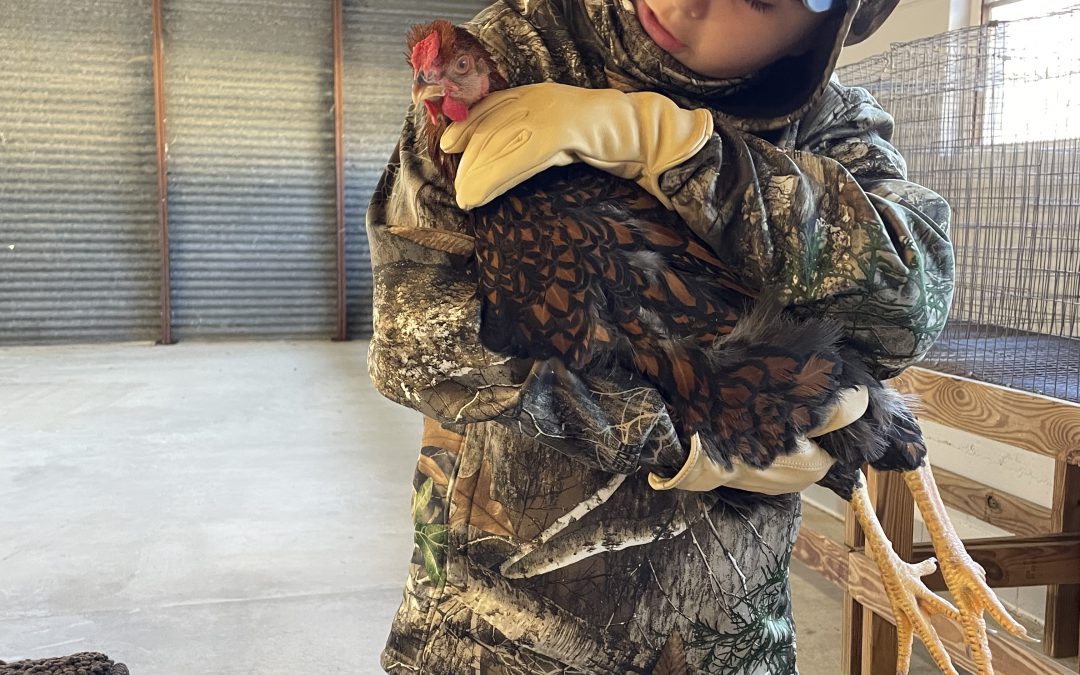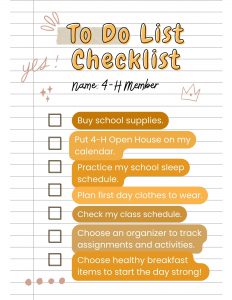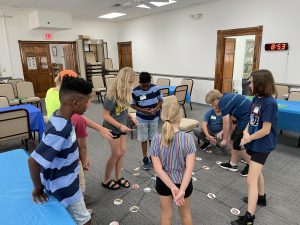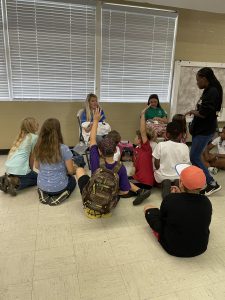
by Prudence Caskey | Jan 11, 2024
As we enjoyed a beautiful Christmas day in the panhandle, we need to start to brace for some colder weather as we welcome the new year. Here are a few ideas on how to protect your animals in the colder weather. During this upcoming cold snap, your “critters” will rely on you to survive it. As you think about how to best protect your outside pets and livestock, remember the three W’s. (more…)
by Rachel Pienta | Jul 28, 2023
While returning to school may be exciting to some children, for others the back-to-school season is a time of anxiety and heightened stress. Whether you are a parent or an adult who works closely with youth, there are steps to take that can help young people manage stress and build a foundation for school success.
In my role with 4-H, I serve as a member of University of Florida faculty specializing in youth development and volunteer systems in the Wakulla County Extension office. My work involves collaborating with and supporting local youth, their families, adult volunteers, and community partners. This summer, I completed Mental Health First Aid Training, a program offered by the National Council for Mental Wellbeing. This training is available to any interested adult or teen. Visit this site for more information: https://www.mentalhealthfirstaid.org/. The training was an excellent refresher that helped bring me up to date on ways to support youth and families in our community. Mental health concerns often differ by age. What may be worrisome to your elementary school aged child has will likely differ from what will trouble your high school aged teen.
Getting the Conversation Started
Over the course of twenty-eight years and counting as an educator, I have had the opportunity to work with youth and young adults ranging from pre-school to college. The one concern I can confidently say that

The new school year is about to start!
youth of any age are likely to share is a fear of the unknown. While the unknowns change from year to year and differ between children, one way to handle potential worries is to talk about them. Consider these conversation starters to help your child discuss the new school year:
- What do you most look forward to experiencing/doing this school year?
- If you could change one thing about the last school year, what would it be? Why?
- What are you most hoping to learn/do this school year?
While some children will take these questions and run with them, other children may be less eager to communicate or just less enthusiastic about the new year. Parents may want to adjust their questions to address stressors that accompany back to school time and how to alleviate those concerns.
Tips for the Early Years of Elementary School
For younger children, driving by the school building may help alleviate nerves. You may not get to visit a classroom inside the school until a scheduled Open House event, but seeing the place and discussing what the school day involves can help to dispel some worry. Tips for easing the back-to-school jitters for elementary school:
- Establish the back-to-school bedtime routine. Helping to get sleep routines back on the school year schedule is a good first step to success.
- Practice the morning routine. Consider timing it. Make it a game. What steps are needed to get everyone out the door on time? Practicing this routine for a few days will help everyone make better school day decisions such as whether to lay out clothes and school supplies the night before, make lunch or snacks the night before, and can help everyone feel less stressed on school days.
- Plan for lunch and practice lunch time skills. If you are sending a packed lunch or snacks, can your child open the packages without help? Does your child like what you are sending? Involving children in planning lunch and snacks can help ensure food is eaten and not wasted.
The American Academy of Pediatrics offers helpful back to school tips for kindergarten through school on the HealthyChildren.Org page located at https://www.healthychildren.org/English/ages-stages/gradeschool/school/Pages/back-to-school-tips.aspx.
Tips to Manage Middle School
In middle school, school expectations for youth increase with each grade level. The Nemours Foundation offers advice specific to the middle school years:
- Visit the school website with your youth. Review school policies together.
- Discuss goals for the school year together. The middle school years offer opportunities to develop organizational skills and start to make choices about how to allocate their time.
- Work together to develop a realistic nutrition plan. Your middle school child may prioritize sleep over a healthy breakfast. Discussing your expectations about how and what your child eats to be well-prepared for the school will help ensure they can follow a plan that works for both of you.
For more tips about supporting your middle school student for success, visit the Nemours Kids Health web page at https://kidshealth.org/en/parents/school-help-middle.html.
Tips to Finish Strong in High School
The high school years come with a different set of stressors and the concerns your child has entering ninth grade will likely be different than the concerns they have entering senior year. For youth entering the ninth grade, high school may seem intimidating. Youth have experienced the heights of eighth grade, when they are the oldest in middle school. Then, ninth grade rolls around and students are back on the lowest rungs of the school pecking order once again. Add the pressure of an environment where grades and extracurricular activities may impact a child’s future beyond the high school years and the perfect formula for stress is created. How can parents support a newly minted high school student?
- Discuss course choices with the school course catalog as a guide. The school guidance counselor can help you locate the guide if it is not available on the school website.
- Determine what goals your child want to set. Do they want to take a language, join a school club, try out for a sport?
- Is your child leaning toward vocational studies? What requirements do they need to fulfill to enter a vocational program?
Setting academic and post-high school goals as early as eighth or ninth grade can help alleviate some stress in the final years of high school. Youth in tenth and eleventh grades will either work to maintain a positive trajectory or they will need to do self-examination to determine how to get back on a track that will get them where they want to go. Youth at this age may be considering after-school jobs or may take advantage of dual enrollment course options.
Youth entering twelfth grade, along with their families, are about to embark on an emotional roller coaster ride. High school seniors and their parents will experience a number of “last time this will happen” moments, beginning with the first day of school. The final year of high school can be bittersweet. This last year will also carry the weight of the future with it. Some youth may find themselves overwhelmed by the unknowns and the many decisions that may be facing them as they prepare for a life beyond high school. To ease some of this stress, have family discussions about the school year before classes begin. Plan on check ins throughout the year. The emotions a student may feel in August may differ significantly from what they are feeling in February when peers begin to receive college acceptances. Possible questions to ask early in senior year:
- What deadlines should we have on our calendar?
- When are payments due for college applications, senior trips, cap and gown, invitations?
- What parts of senior year do you want family members to experience and what part of senior year will be just for you and your friends? This is the time to start planning for sports or band senior nights, gatherings for Homecoming or Prom, and graduation parties.
Handling Challenges and Opportunities Together

Follow these tips to start school strong this year!
Whether you are the nervous parent of a kindergartener or the proud parent of a high school senior, the new school year will bring challenges to manage as well as opportunities to make new family memories. Planning ahead and keeping the lines of communication flowing between family members will help the school year flow more smoothly for parents and students alike. If you are looking for new youth or volunteer activities to add to your family’s routine this school year, consider contacting your local Extension office for youth activities and volunteer opportunities.
Additional Back-to-School Stress Management Resources
The American Institute of Stress. (2019). 15 Ways to Beat Back-to-School Stress. Retrieved July 25, 2023 from https://www.stress.org/15-ways-to-beat-back-to-school-stress.
Borenstein, J. (2019). Back-to-School Stress Management. Brain and Behavior Research Foundation.
Retrieved July 25, 2023 from https://www.bbrfoundation.org/blog/back-school-stress-management#:~:text=Each%20weekend%2C%20spend%20some%20time,likely%20to%20stick%20to%20them.
JED Foundation. (2023). 8 Ways to Lower Stress in High School. Retrieved July 25, 2023 from https://jedfoundation.org/resource/8-ways-to-lower-stress-in-high-school/.
by Claire Davis | May 6, 2022
 How do you know when it is appropriate to send a thank you card? Have you ever received a gift from someone? Did a volunteer donate their time for an event or for a club meeting? Are you in 4-H and someone purchased your project animal at auction? If you answered yes to any of these questions, then you should have written a thank you note to them! It does not just have to be a life changing event, such as a wedding, birthday, or baby shower, that warrants a thank you card. Whenever someone has done something nice for you, it is definitely worth sending them a thank you card.
How do you know when it is appropriate to send a thank you card? Have you ever received a gift from someone? Did a volunteer donate their time for an event or for a club meeting? Are you in 4-H and someone purchased your project animal at auction? If you answered yes to any of these questions, then you should have written a thank you note to them! It does not just have to be a life changing event, such as a wedding, birthday, or baby shower, that warrants a thank you card. Whenever someone has done something nice for you, it is definitely worth sending them a thank you card.
Writing thank you notes is a skill that many people should have, but many overlook. What exactly do you need to say in your thank you note? Here is an easy guide for a few things that you should include in your thank you note, regardless of the reason you are writing it!
Make sure that you start off by thinking of why you are writing a thank you note! Thank you notes let the individuals know that you care, that you are proud of your accomplishments, or make them feel appreciated for something that they have done for you!
-

A decorated academic cap at commencement. Photo taken 04-29-17.
Make the letter personal by starting with a salutation. Address the individual(s) by their name. If it is someone that you are well acquainted with, it is alright for you to address them by their first name. If it is someone that you are not as familiar with, stick to Mr., Mrs., Ms, and/or Miss last name. Below are a few examples of how to address someone:
Dear Aunt Renae,
Dear Lilly,
Dear Mr. and Mrs. Leonard,
- Get right to the point and express your gratitude. Some examples could be:
“Thank you so much for your generous wedding gift.”
“Thank you for the birthday present.”
“Thank you for donating your time at the Horse Club Meeting.”
“Thank you for purchasing my steer at the Calhoun County Livestock Show.”
- Maybe mention a specific detail or two. There is no need to exaggerate about their gift, but tell them what it might be used for or what you appreciate about it. Here are a few examples of things to say.
“I am so excited to get to use the birthday money on my upcoming trip to Disney World.”
“I’ve had my eye on a smoothie maker, and now I am a smoothie making machine!”
“We are saving the wedding money to help build our future home together.”
“The knowledge you shared at the meeting is incredibly valuable and the kids were soaking it up!”
“I am going to save the money from my 4-H steer project in my college fund.”
- Look ahead to the future. You may be excited about your trip to Disney World or the new smoothie machine, but make sure they know that you appreciate them or enjoyed working with them. If you are likely to spend time with them again in the future, this is a good way to move your letter towards wrapping up.***This suggestion may not apply to every letter.
“I can’t wait to have dinner with you again.”
“I’ll be up that way here in a few months and would love to see you.”
“I am interested in the position and look forward to hearing from you soon.”
“We cannot wait to have you teach us again at the club meeting next month.”
- Wrap it up with another thank you and sign off. Make sure that your letter is clear, you want to thank them for their time, donation, money, etc. You do not have to use fancy language to end your letter.
“Thank you again for thinking of us on our special day!”
“Thank you for being so generous to our organization.”
“Again, thank you for spending your time with us.”

Albert the Alligator Florida Gator mascot holding a thank you sign. Photo taken 11-16-16.
Make sure to end your letter appropriately, whether that be professionally or casually.
“Warmly,”
“With love,”
“Sincerely,”
When in doubt, write a thank you card. Your recipient will feel extra special that you want to show them your gratitude!
by Allison Leo | Apr 29, 2022
Benefits of being recognized

Ways to feel special without food! Youth receiving rosette for a job well done!
One of the most important aspects of working with youth is the relationships that we build with them. Recognition is a basic human need, and in 4-H, recognition of youth members for their knowledge gained and mastery of skills is an important part of our positive youth development program. Using incentives and prizes during a 4-H program can be an effective way to create a sense of belonging. While working with youth, it is important to acknowledge their achievements and hard work throughout the club year.
Using Food as a Reward
Candy and sweets are often used to reward good behavior or accomplishments because kids like them and they are inexpensive. It is tempting to lean towards sweets and candy when selecting rewards and prizes for youth, but when food is given as a reward, children start to connect it to good or bad, and not fuel for the body. Rewarding youth with sweets can contradict the teaching and modeling of behaviors that promote healthy life skills in 4-H. Often, these foods have little or no nutritional value.
Non-food Rewards
Non-food rewards are a great option for acknowledging youth at 4-H club meetings, in school, and while at home. By using non-food rewards to acknowledge behavior, this promotes a healthy environment and helps children develop a healthy relationship with food. Recognizing youth with words of appreciation are better motivators than rewards of food. Telling a child, “I am so impressed with how hard you worked on your project,” is a healthy alternative to giving them candy for their success.
Creating an Inclusive Environment
Non-food rewards also create an inclusive environment for those we have food allergies and cannot partake in many food rewards. The Centers for Disease Control and Prevention’s (CDC) “Voluntary Guidelines for Managing Food Allergies in Schools and Early Care and Education Programs” recommends the “use of non-food incentives for prizes, gifts, and awards.” While a shift to non-food incentives may require slight changes to traditions, there are many potential benefits. Below is a list of free and low-cost reward options to use with kids.
Free
- Certificate
- Lead a game or activity
- Help teach lesson
- Trip to the park

Examples of non food reward items.
- Special privilege at home or club meeting
- Book exchange
Low-cost rewards
- Stickers
- Stress balls
- Notepads
- receive a plant, seeds and a pot for growing
- Pencils
- Art supplies
- Coloring book g
- Glitter
- Bookmarks
- Cupcake Wrapper Rosette
- Small toys
- Stencils
Group rewards
- Bowling party
- Field day
- Movie day
- Trip to a community park
- Canoe or kayak trip
by Prudence Caskey | Apr 1, 2022

To get help for someone call or text this number
Understanding Signs of Human Trafficking
The common misconception when the average person hears about human trafficking is that the victim has been kidnapped and sold into slavery across the world. The visions of young people restrained in the back of a semi tuck or cargo ship may come to mind. The reality of the matter is kidnapping of victims only happens in about 9% of these cases. The sad fact is that most victims are trafficked by someone they know and trusted at one point. Many victims even feel they are doing their trafficker a favor now and then in exchange for a new cell phone, video game, or some other type of prized possession.
Understanding the signs of human trafficking is the first step to helping the victims find their freedom. Many youth who are venerable can be influenced and controlled by savvy individuals they initially see as a trusted adult. Through research, the susceptible victims are targeted and are in over their heads before they know what has happened. Often, these victims feel stuck without any hopes of relief or rescue.
The signs to look for are subtle and for experienced traffickers, sometimes well hidden. A sudden change in appearance or attitude could be a sign of youth hanging out with a new crowd. If you notice youth that have a new friend who is considerably older, this could also be a signal that the relationship may not be healthy. Here is a sample of additional signs to look for:
- Sudden absences from school
- Repeatedly running away
- Abrupt change in attire, behavior, or relationships
- The existence of an older “boyfriend” or “girlfriend”
- Being escorted by an older male or female who is not their guardian
- Sudden existence of costly material belongings
- Homelessness
- Signs of psychological pressure, such as anxiety, depression,
- An overly submissive attitude
- Tattoos or other branding marks
- Lack of control over their schedule or money
- Unable to possess their own proof of identification
- Signs of physical trauma (like bruises, cuts, burns, or scars)
- Coached or rehearsed responses to questions
If you are a trusted adult and changes are noticed, a few well-placed questions, may help the victim open up a little. Victims may be resistant to questioning but may speak more freely with an open-ended conversation. Can you tell me more about, “the new friend’s name here”? What do you do when you hang out with “new friend”? Why did “new friend” buy you such a nice cell phone? It is not necessary to confirm abuse before calling the Florida Abuse Hotline to report suspicion. Remember, these victims can also be young adults that have been trapped inside a human trafficking ring for years. If abuse is suspected, please call Florida Abuse Hotline (report abuse for children) TEL: 1-800-962-2873 TTY: 1-800-4955-8771 The Florida Abuse Hotline accepts reports 24 hours a day and 7 days a week of known or suspected child abuse, neglect, or abandonment and reports of known or suspected abuse, neglect, or exploitation of a vulnerable adult. Please use the links below to report a child or adult abuse. National Human Trafficking Resource Center 24/7 (for adults). 1 (888) 373-7888
BeFree Textline 24/7 Text HELP to 233733 (BEFREE) Send a text for crisis support, referrals, and more – to get help for victims and survivors of human trafficking or to connect with local services.
by Claire Davis | Feb 11, 2022
Like me, you make ask, what is a “sense of belonging”? Have you ever felt out of place when going to a club, meeting, or gathering? Do you remember how it made you feel? Maybe you were nervous, had a funny feeling in your stomach, a knot in your throat, or weren’t sure if you belonged?

Volunteer working with youth. Calhoun County Animal Science Camp 2021
One of the essential elements of 4-H Youth Development is belonging. Youth members need to know that they are important to you, cared for by others, and feel a sense of connection to the group they are in! As a facilitator of a 4-H activity, whether that be volunteer, adult, or Extension agent, it is important to provide youth with a safe, inclusive environment when participating in groups. When the facilitator creates a space where youth feel physically and emotionally safe, youth tend to form positive relationships with their peers and role models. Feeling connected to others will affect their behavior, mental health, academics, as well as other life skills. Creating this sense of belonging for all participants is a solid foundation to build a program on!
Now you may be asking, how on earth can I create a sense of belonging?
Since you are the adult facilitator in this setting, it’s your job to provide youth with the opportunity to feel safe during activities. To do this, use discussion questions that engage all the youth members, and encourage them to learn from each other. Below are a few ideas to foster this sense of belonging.
- Welcome new members. Youth who are already part of the group will feel more comfortable than those that are just starting. Assign existing members a role in welcoming newcomers, similar to a welcoming committee. 4-H and other group activities like team sports, can be overwhelming because there is a lot of information given, so think about preparing welcome packets for new members or families. These packets could include information on how to enroll in 4-H Online, club calendars, brochures, frequently asked questions, contact information, and more!
- Ice breakers. Ice breakers and team building activities are really important to help all members feel

Calhoun County Animal Science Camp Ice-Breaker. What is Agriculture? Summer 2021
comfortable with each other! These types of interactions help build relationships within the group. These are helpful when a group is just starting out, as well as continuing to build bonds overtime. Being deliberate in choosing these types of activities will help any group feel more cohesive. Adjust the activity to suit the group that is participating. Keep it simple for cloverbud age youth (5-7) or add challenges if the group is older or has been together for a period of time. “Ice breakers, get acquainted games, or even roll calls that ask questions about member’s interests (answer roll by making the sound of your favorite animal) can help members get to know each other better.” (Kent, 2015)
- Create a safe space. It may seem easy to create a safe space for youth and other adults but it’s much more difficult in practice! We all think about keeping youth safe physically, but what about the emotional aspect of safety? We must be aware of “microaggressions”, which is defined as a statement, action, or incident regarded as an instance of indirect, subtle, or unintentional discrimination against members of a marginalized group such as a racial or ethnic minority. As a leader, you will want to be able to identify these so you can educate and redirect the situation. It is our job, as adults, to help youth, and other adults, understand the impacts of their words. Creating a shared set of ground rules for everyone to follow can help everyone feel comfortable, knowing the expectations of the group as well as having a voice in creating the space.

Intro to Animal Handling- Gulf County Summer Camp 2021
- Encourage engagement. Engaging youth members can be done in multiple ways! Various options include using discussion questions, club committees, or even silly ice breaker games – anything constructive to grab and hold their attention. Using discussion questions allows youth to learn from each other while also encouraging a sense of curiosity for life-long learning. Having different committees allows for smaller work groups, which is much less intimidating than a single large group. It is easier for opinions and thoughts to be heard in a smaller setting. Ice breakers may seem silly, but they are a fun and wonderful way to get youth involved.
While a sense of belonging is important for youth, it may take some time and intentionality to create the space to provide the sense of belonging. Our youth members come from all different walks of life and as the adult leader, you must think about the challenges youth may face that makes them different. Some youth may look different physically; some may come from a family that has never done 4-H; some may have experienced trauma; some may have special needs.
A 4-H club, program, or activity can provide a space that youth belong to, as well as allowing them to learn invaluable life skills. Adults, volunteers, and agents are essential to creating this space, while also helping other members see how to increase the sense of belonging for others. What will you do to help make all members feel welcome?
Sources:
https://www.canr.msu.edu/news/essential-elements-of-4-h-belonging
Creating a Welcoming Environment in 4-H Clubs












